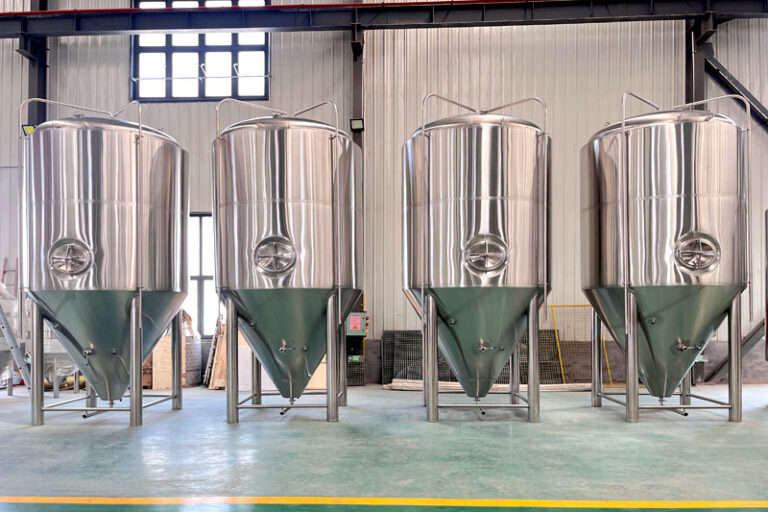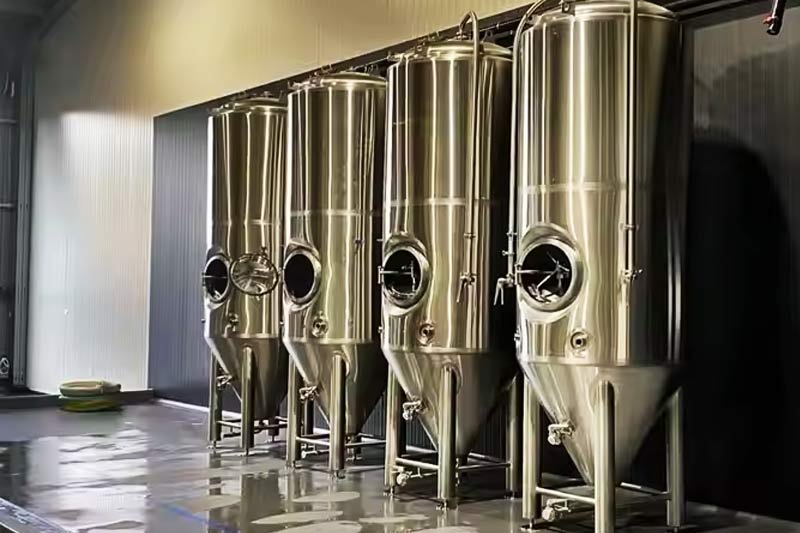What is a stainless steel fermentation tank?
A stainless steel fermentation tank is a container used to implement the fermentation process. It is usually made of stainless steel and has good corrosion resistance, heat resistance, and mechanical strength. The fermentation tank is equipped with agitators, temperature and pressure sensors, ventilation devices, and other control systems to achieve precise control of the microbial growth environment.
In the brewing industry, fermentation tanks play a vital role in beer production. These containers are usually made of high-quality stainless steel and provide a controlled environment for primary fermentation and maturation. Brewers use these stainless steel fermentation tanks to ensure that the fermentation liquid maintains the appropriate fermentation temperature. These tanks are made of food-grade materials to prevent contamination and corrosion so that the wort can be safely processed and flavors can be produced through microorganisms.

Main uses of stainless steel fermentation tanks
Food industry
- Beer and wine: Fermentation tanks are responsible for providing the ideal temperature and atmosphere during the production of beer and wine, promoting yeast fermentation and sugar conversion to form alcohol and other flavor components.
- Dairy products: Stainless steel fermentation tanks are widely used in the production of dairy products such as yogurt and cheese. By controlling the temperature and adding bacteria, the fermentation of lactic acid bacteria can be promoted, which can improve the flavor and nutritional content of dairy products.
- For fermented condiments: Such as vinegar, soy sauce, etc., the fermentation process needs to control pH and temperature to ensure flavor and shelf life. Stainless steel fermentation tanks can provide a stable fermentation environment.
Pharmaceutical industry
- Antibiotic production: Stainless steel fermentation tanks are used to produce a variety of antibiotics, such as penicillin and erythromycin, which rely on the fermentation process of microorganisms. The yield can be improved by precisely controlling the fermentation conditions.
- Vaccine production: By culturing specific pathogens or cell lines, people can produce vaccines in fermentation tanks. The design of the fermentation tank ensures a sterile and efficient production environment.
- Biopharmaceuticals: Many modern biopharmaceutical products rely on cell fermentation technology. The use of stainless steel fermentation tanks simplifies the production process of these products.
Environmental protection and sewage treatment
- Anaerobic digestion: In the process of wastewater treatment, anaerobic digestion is carried out in stainless steel fermentation tanks to convert organic waste into biogas (such as methane) and solid fertilizer. This process not only reduces waste but also provides renewable energy.
- Bioremediation: Using stainless steel fermentation tanks to cultivate specific microorganisms can be used for pollutant remediation in soil and water bodies, and effectively treat industrial wastewater and heavy metal pollution.
Other industrial applications
- Biodiesel production: Extracting oils from organic matter through fermentation technology and converting them into biodiesel using the catalytic action of enzymes has the advantages of environmental protection and renewable energy.
- Fermentation of plant extracts: Extracting active ingredients (such as polyphenols, flavonoids, etc.) from plants can use fermentation technology to improve the quality and bioavailability of extracts.
Technical advantages of stainless steel fermentation tanks
- Excellent corrosion resistance: Stainless steel exhibits good corrosion resistance in many chemical and microbial environments, reducing maintenance costs and production losses caused by corrosion.
- Stable mechanical strength: Stainless steel has high mechanical strength, high temperature, and high-pressure resistance, and is suitable for extreme working conditions, ensuring the safety and stability of the fermentation process.
- Easy to clean and maintain: The surface of stainless steel fermentation tanks is smooth, easy to clean, and meets hygiene standards, which is particularly important for the food and pharmaceutical industries.
- Precise temperature and pressure control: Modern stainless steel fermentation tanks are equipped with advanced temperature and pressure control systems that can monitor and adjust fermentation conditions in real-time, thereby ensuring an efficient fermentation process.

Basic classification of fermentation tanks
Open fermentation tanks
Open fermentation tanks usually have no top cover, allowing air circulation, which is suitable for traditional beer brewing with natural yeast culture. Since open fermentation tanks allow the yeast to naturally contact oxygen in the air, making the yeast more active, this tank is suitable for brewing certain types of wheat beer or sour beer. However, due to its open nature, it is easily contaminated, so the sanitation conditions of the environment are relatively high.
Closed fermentation tanks
Closed fermentation tanks have a sealed design and are usually equipped with pressure control and gas escape devices. This tank allows fermentation under controlled oxygen conditions and is suitable for modern beer production. This fermentation method can improve the efficiency of fermentation and better control temperature and pressure, thereby ensuring the brewing of higher quality beer, especially fortified beer and lager. A big advantage of closed-circuit fermentation is that it can reduce the impact of oxygen on the finished product, thereby maintaining the fresh taste of beer.
Top fermentation tanks
Top fermentation tanks are used for brewing top-fermented (Ale) beer, and the yeast used will float to the surface of the liquid during the fermentation process. The standard temperature of this type of tank is generally higher, usually between 15℃ and 24℃, suitable for brewing beers such as IPA (India Pale Ale) and Porter. This yeast is more active, ferments faster, and can produce rich aroma and flavor.
Bottom fermentation tank
The bottom fermentation tank is suitable for brewing bottom fermentation (Lager) beer, and this yeast will settle to the bottom of the tank during the fermentation process. The temperature of bottom fermentation is usually lower, generally between 6℃ and 12℃, which can produce a refreshing taste and reduce the generation of off-flavors. Many classic beer styles, such as Belgian Lager and Bavarian beer, are brewed in this tank.
Primary fermentation tank
The primary fermentation tank only undergoes one fermentation during the brewing process, and the beer is discharged directly from the tank after the fermentation is completed. This method is usually suitable for small breweries or laboratories, which is convenient for operation and management.
Secondary fermentation tank
The secondary fermentation tank is used to transfer the beer to the second tank for further maturation and refinement after the first fermentation. At this stage, the taste and flavor of the beer are further improved, and impurities and undesirable components can be removed. It ensures the stability and clarity of the finished product, so it is widely used in large breweries.

Stainless steel fermentation tanks
Glass fermentation tanks
FAQ
What are the main advantages of stainless steel fermentation tanks?
Stainless steel fermentation tanks have excellent corrosion resistance, high-temperature resistance, and strength, and can resist the chemicals produced during the fermentation process. Stainless steel has a smooth surface, is easy to clean and disinfect, and meets hygiene standards. In addition, its structure is stable and has a long service life.
What are the advantages of stainless steel fermentation tanks compared to other materials?
Compared with glass or plastic fermentation tanks, stainless steel fermentation tanks are more durable and strong and are not easy to break. Stainless steel can also maintain its performance under high temperatures and high-pressure conditions. In addition, stainless steel tanks have better sealing, which helps to prevent oxygen from entering and maintain a stable fermentation environment.
What types of beverages are suitable for stainless steel fermentation tanks?
Stainless steel fermentation tanks are suitable for fermenting a variety of beverages, including beer, wine, fruit wine, and yogurt. They are widely used in commercial breweries and food processing plants.
How to clean and maintain stainless steel fermentation tanks?
When cleaning, you can use warm water and neutral detergents, and avoid using abrasive ingredients or chemical detergents with strong acids and alkalis. Rinse thoroughly after cleaning to ensure that there is no detergent residue. Perform deep cleaning and disinfection regularly to keep the equipment hygienic.

